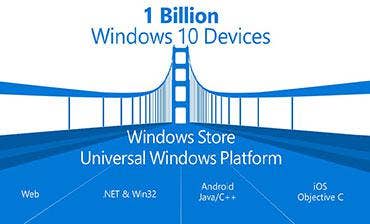Microsoft Lures Android, iOS Developers With Vision For 1 Billion Windows 10 Devices

Microsoft has set a goal of getting Windows 10 running on one billion devices in the next two to three years, and now it's trying to make it easier for Apple and Android developers to get in on the action.
Windows 10, slated for worldwide release this summer, will run on all kinds of devices, from smartphones and small tablets to PCs and digital displays. This wide range of devices -- and an expected 1 billion-strong base of devices running it -- will greatly expand opportunities for developers, according to CEO Satya Nadella.
"We want to make sure every developer has the widest user base to target with your apps," Nadella said Wednesday at Microsoft's Build conference in downtown San Francisco.
[Related: Microsoft's Cloud Business Booms, But Windows Takes Beating In Mixed Q3]
At the event, Microsoft unveiled four new ways for developers to build apps in Windows 10 using the code they've built for apps on other platforms.
Developers will be able to take nearly all of the Java and C++ code they use to build Android apps and use it to build apps that run on Windows 10 devices, said Terry Myerson, executive vice president of Microsoft's Operating Systems group (OSG).
Myerson said Windows Phones will include an Android subsystem that will let them run apps that use both Android and Windows 10 code. This could let an Android developer expand the scope to Windows 10 and target the expected 1 billion-plus device base, he said.
Microsoft also unveiled technology for building Windows Universal Apps -- which run on any kind of device -- using Apple's Objective-C language. Developers can now compile the same code they use to build iOS apps on Windows 10, thereby taking advantage of capabilities only Windows has, Myerson said.
King, the developer of Candy Crush Saga, used this technology to bring the wildly popular game to Windows Phone, and it's planning to release more games for Windows 10, said Myerson.
What Microsoft unveiled Wednesday is basically the reverse of what Xamarin, a mobile vendor that lets developers code Android and iOS apps using Microsoft's C# programming language, offers today.
Xamarin was the star of last year's Build conference and was said to be in acquisition talks with Microsoft in the weeks leading up to the event. But so far, this year's Build event focused on cross-platform tools that Microsoft developed itself.
Microsoft partners told CRN the new technologies are yet another sign of Microsoft's growing commitment to cross-platform app development.
"This is an interesting and powerful move for Microsoft," Kevin Ford, mobile development practice lead at Magenic, a St. Louis Park, Minn.-based Microsoft development partner, told CRN.
Making it possible to run native Android apps in a subsystem on Windows 10, and to compile Apple Objective-C code to run on Windows 10, could make life easier for companies like Magenic that write custom code, Ford said.
"Suddenly Java and Objective-C projects have the potential to be cross-platform with Windows 10," Ford told CRN. "For our enterprise customers, this means they can extend their applications to hit the Windows 10 platform at a much lower price point than they had previously."
Richard Campbell, principal at Coquitlam, B.C.-based development firm Campbell Associates, said 1 billion Windows 10 users could benefit developers by giving them a larger potential target audience.
"More seats always means more opportunity. It's just a question of what it takes to get at those seats," said Campbell.
Microsoft is also enabling developers to bring new apps to Windows Store. This means apps built on .NET and Win32, two popular technologies in the Microsoft developer community, can be imbued with the ability to run on any kind of device that runs Windows 10.
"We will be adding support for bringing .NET and Win32 apps into the Windows Store and take advantage of Windows Universal Apps capabilities," Myerson said.
Chris Hertz, CEO of New Signature, a Washington, D.C.-based Microsoft partner, said he's jazzed about Windows 10's deep integration with Microsoft public cloud services, which he thinks will fuel more enterprise business.
"Windows 10 will be a much easier way for IT professionals to ensure that they're able to migrate all their Windows users to a modern client experience, without the challenges of the past," Hertz said.
PUBLISHED APRIL 29, 2015